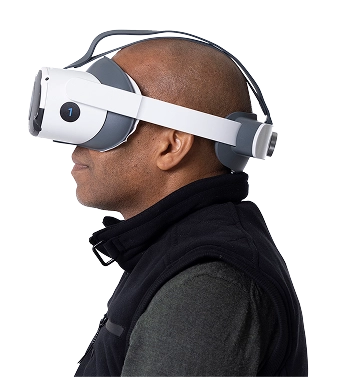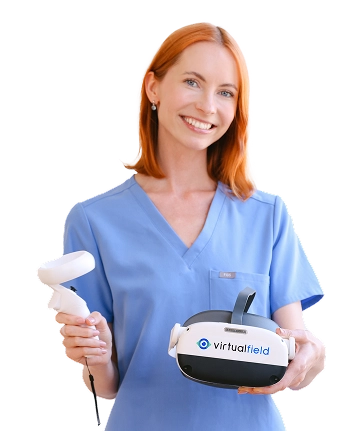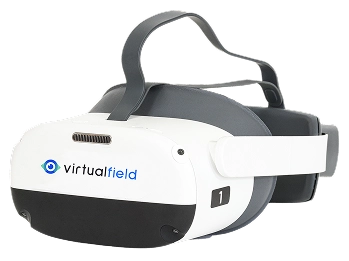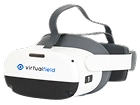The foveal region of the macula is responsible for the sharpest central vision, and it’s here that conditions like diabetic retinopathy and macular degeneration first cause damage. You’ll need a highly sensitive, specialized test that provides detailed insights to slow disease progression in this part of the eye. The foveal threshold exam can help you intervene early and provide more targeted treatment to patients needing care.
The foveal threshold test is a powerful, specialized exam used to evaluate central sensitivity visual field within the foveal region of the retina. This region is often the first to show signs of conditions like macular degeneration or diabetic retinopathy. With a portable foveal threshold device like Virtual Field, clinicians can deliver faster, more accurate, and more comfortable testing experiences while capturing critical data for early intervention and precise treatment planning.
What Is the Foveal Threshold Test and Why Central Sensitivity Visual Field Matters
The portable foveal threshold test measures the sensitivity of the central visual field, specifically within the foveal area, and covers a radius of about 10-15 degrees. It helps detect early changes in visual function in the macula and surrounding retina, which is critical for tasks like reading and recognizing faces. These insights make the test especially useful in identifying conditions like age-related macular degeneration (AMD), diabetic maculopathy or retinopathy, and other retinal conditions. With this level of sensitivity, you can differentiate between different types of visual field defects, like paracentral or ring scotomas versus central scotomas.
Virtual Field is key for evaluating central visual field defects using a macular visual field device. It streamlines the exam with real-time analysis, immediate reporting, condition monitoring, and a patient-friendly physical form factor. These features help mitigate patient fatigue and improve accessibility, which is especially important for older patients or those with disabilities.
Academic references and clinical validation
The foveal threshold can be compared with the patient’s visual acuity to detect early damage. Research shows this measurement can also provide a reliable estimate of best-corrected visual acuity.
This study supports using the foveal threshold exam for measuring central vision in advanced glaucoma. This measurement is closely connected to vision clarity, central vision sensitivity, and blood flow in the eye, so foveal threshold testing may help track the progression of glaucoma. This makes the foveal threshold test a valuable tool in managing central sensitivity visual field conditions
This study shows that the foveal threshold exam can help predict vision improvement after treatment for age-related macular degeneration. Researchers found that patients with a higher foveal threshold and healthier photoreceptors before treatment were more likely to have better vision after 12 months of intravitreal aflibercept therapy.
Virtual Field is proud of its commitment to the highest security and quality assurance standards. We are SOC 2 Type 2, HIPAA, FDA, and Health Canada compliant.


30 days free.
No strings attached.
We are confident you’ll love Virtual Field just like the 2,000 doctors who have already made the switch.
Key Benefits and Limitations of the Portable Foveal Threshold Test
One of the Virtual Field foveal test's main strengths is its ability to detect early signs of vision loss. This capability gives you time to intervene before it affects the patient’s daily activities like reading, driving, and recognizing faces. But because it focuses primarily on the central field of vision, the portable foveal threshold exam may miss peripheral defects and overlook common conditions like glaucoma. This test is relatively fast to conduct, so adding it to your routine macular degeneration screenings means more comprehensive patient care without straining your workflows and exam schedule timelines.
Pros and cons of the N-30 Exam
The pros and cons that follow can help guide you toward the ideal scenarios to incorporate this test into your patients' diagnostic assessments.
Pros
The foveal threshold exam is highly sensitive and suited for detecting early stages of disease.
A precise focus on the central 10-15 degrees of vision gives the clearest picture of foveal function compared to other exams.
The foveal threshold exam helps track progressive conditions like macular degeneration and diabetic retinopathy, which are extremely common.
This test is one of the shorter visual exams, so patient fatigue is usually low.
Cons
The foveal threshold exam focuses exclusively on central vision, so it does not detect most peripheral defects.
Patients at risk of glaucoma and those who show signs of peripheral vision loss will need additional testing.
When using traditional methods, patients may need to wear an eye patch. This experience can increase anxiety or interfere with test results.
This test can be challenging for patients as they try to detect low-decibel stimuli.
Ocular Diseases Diagnosed Using a Macular Visual Field Device
These conditions can all impact central sensitivity visual field, which is why the foveal threshold test is key. Using a macular visual field device like Virtual Field allows earlier detection and disease monitoring for patients with macular degeneration or diabetic retinopathy.
Age-Related Macular Degeneration (AMD)
Almost 20 million Americans age 40 and over have AMD. The foveal threshold exam detects early visual function decline in the macula and helps you diagnose AMD, preserving more vision.
Macular Edema
Another condition often linked to diabetes, macular edema, can lead to a decrease in foveal sensitivity. The foveal threshold test helps monitor the extent of edema and its impact on central vision.

60+
Macular Degeneration is the leading cause of vision loss in Americans aged 60 and older
2.5M
AMD affects 2.5 million Canadians
Diabetic Retinopathy
One in ten Americans has diabetes, and 26% of them experience diabetic retinopathy. Diabetic retinopathy can cause subtle macular changes that the foveal threshold test can identify early. Recognizing these changes allows for timely management and helps prevent further vision loss in people with diabetes.
Macular Hole
A macular hole can cause defects in central vision. The foveal threshold exam is highly sensitive in detecting the early stages of macular hole development and helps support more prompt intervention.
Other Conditions
The foveal threshold exam can also monitor:
- Retinal vein occlusion
- Optic neuropathy
30 days free.
No strings attached.
We are confident you’ll love Virtual Field just like the 2,000 doctors who have already made the switch.

Billing and CPT Codes for Foveal Threshold Tests
The foveal threshold test, as performed by Virtual Field’s macular visual field device, is typically reimbursable under CPT 92083., which is reserved for a comprehensive, extended visual field exam with quantitative testing.
The Medical Physician Fee Schedule (MPFS) currently indicates reimbursement between $25 and $80. This range is wide because factors such as practice location, setting, and modifiers can impact fees.
When is the foveal threshold exam required?
This exam can be incorporated into routine, comprehensive visual field assessments — especially for patients at risk of macular degeneration, diabetic retinopathy, or macular edema. It should be high on your list of screenings when a patient reports difficulty with tasks that require sharp central vision, like reading or driving. This test can also be helpful for patients with a family history of macular diseases or those taking medications that affect the retina.
This test should also be conducted regularly for patients with known macular conditions to assess and adjust treatment plans.
Is the foveal threshold test required for driver’s licenses?
The foveal threshold exam isn’t required for driver’s licenses, and its test results have limited usefulness relative to driving capabilities. That said, patients with conditions that affect their central vision should be carefully monitored, as this can impact their ability to drive safely. Patients with macular degeneration or a sudden change in central vision may struggle to read road signs or notice obstacles, and visual testing may be required.
Start Testing Central Vision with the Virtual Field Foveal Test
The foveal threshold exam is designed to precisely measure central vision sensitivity, focusing strongly on the fovea and surrounding macula. For patients at risk of AMD or those with diabetes, the foveal threshold exam should be part of their routine screenings.
With the Virtual Field foveal test, you're equipped to deliver precision care using the most advanced portable foveal threshold technology available. With our efficient, intuitive interface, collecting the data you need to make informed treatment decisions and monitor subtle changes is easy. And since Virtual Field’s headsets were designed to improve the patient experience and overcome accessibility barriers, you can offer comprehensive testing to more of your patients who need it.
Want all 23 exam guides in one place?
Download our comprehensive guide for 160+ pages of insights.
FAQs
1. What does a foveal threshold value of 25 dB indicate?
2. Is the single point foveal test CPT billable?
3. How quickly can I run a foveal threshold?
4. When should I add a foveal test to a 24-2?
5. Does lens opacity affect results?
6. Can baseline foveal data guide low-vision rehab?
Ready to get started?
Schedule a demo or begin your 30-day free trial of Virtual Field to try our EOM exam in your practice.

Questions? Contact sales@virtualfield.io talk to a Virtual Field expert today.


